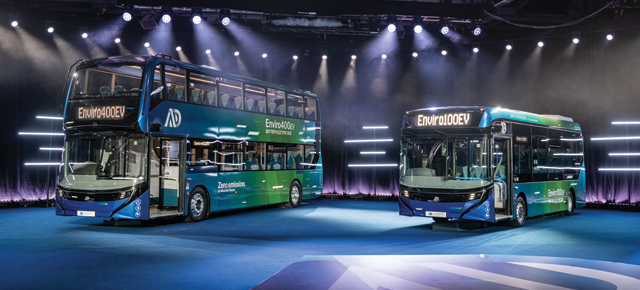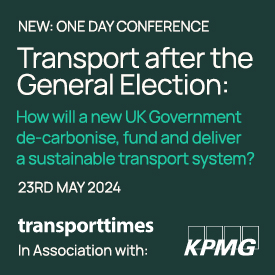After several years working with Chinese manufacturer BYD, Alexander Dennis has launched two new electric buses engineered fully in-house

BY Andrew Garnett
Alexander Dennis (ADL) has worked closely with Chinese battery and electric vehicle giant BYD since 2016 when the first batch of 51 Enviro200EV electric single deckers first entered service with Go-Ahead London on the now defunct ‘Red Arrow’ commuter network in central London.
Since then the partnership has gone from strength to strength with ADL and BYD delivering their 1,500th bus this summer. Although ADL stresses this partnership will continue, it has now decided to strike out on its own with a new range of electric buses that have been engineered in-house from the ground up.
Of course, there have been experiments before. In 2018 ADL partnered with now-troubled US electric bus manufacturer Proterra to offer an electric version of the Enviro500 for the North American market. Meanwhile, ADL has also struck out on its own and developed a hydrogen fuel cell version of the Enviro400 that has won orders from the Liverpool City Region Combined Authority.
We’re giving authorities and operators more choice, more flexibility and more value
ADL is currently focusing on two products: the Enviro100EV midibus and Enviro400EV double decker, both featuring “a stunning new design language that emphasises their zero-emission credentials”. That look was first seen earlier this year with the launch of the Enviro500EV double decker for the Asia Pacific market.
Launching the two new buses at a special event in Farnborough this week, ADL president and managing director Paul Davies added: “We’re giving authorities and operators more choice, more flexibility and more value with our next generation of battery-electric buses.”
Clean sheet approach
While the new zero-emission driveline for the Enviro400EV is an in-house creation, ADL has collaborated closely with technology partners. It’s evident that a fresh perspective has been taken to address some deficiencies with the Enviro400EV design that was developed in partnership with BYD.
Overall dimensions are 11.1 metres by 2.55 metres with a wheelbase of 5.9 metres, giving a maximum passenger capacity of 96 passengers with up to 80 seats (51 upstairs and 29 on the lower deck). Commentators will be pleased to note the ‘dickey seat’ style awkward seating arrangement at the rear of the lower deck on the BYD-derived Enviro400EV has been replaced with a more conventional layout.
Meanwhile, passenger and driver comfort is ensured with a heating and cooling system that uses forced air circulation and a zero-emission heat pump. The cab area has also been improved with a new steering wheel and configurable dashboard display.
A redesigned geometry of the vehicle front provides drivers with better direct vision and protects vulnerable road users. Chris Gall, ADL’s group engineering director, said the manufacturer was applying proven principles from the car industry to buses, creating angles that “deflect rather than impact” and improve visibility for the driver. The design meets current and upcoming targets of Transport for London’s stringent Bus Safety Standard.
There is a choice of charging systems on the new Enviro400EV for different applications with dual-sided CCS2 DC connectors charging at up to 150kW or an optional roof-mounted charging system for up to 300kW of opportunity charging via roof-mounted rail and pantograph.
The electric motor in these buses is the Voith Electrical Drive System HD, boasting an impressive 410kW peak power and a continuous power output of 310kW. Regarding the battery system, the new Enviro400EV is equipped with Impact’s NMC lithium-ion battery. Two options are available: a 354kWh battery or a larger 472kWh variant. The battery packs are mounted within the chassis and rear of the vehicle as well as under the staircase.
In terms of range, that battery capacity translates into up to 195 miles on a single charge, or an even more substantial 260 miles with that larger battery option when brand new.
Evolving battery technology, especially solid-state batteries, could significantly impact EV ranges and charging times. ADL highlights the battery packs’ easy replaceability to accommodate this and Impact is already planning upgraded NMC batteries for ADL that are expected to further extend range.
However, analysis suggests that the typical Enviro400EV will be able to cover two consecutive seven-year contract terms on a typical Transport for London route without a battery change. Outside London, a 20-year operational life would require one mid-life change of batteries. Interestingly, ADL claims it will be in the position to offer its customers a 20-year total cost of ownership calculation.
Small bus: big ambitions
The Enviro400EV will be assembled at ADL’s Larbert facility where the manufacturer has introduced digital support tools and streamlined the build process, reducing the number of stages involved. These changes aim to enhance material, process, and quality control.
These updated methods will be gradually implemented across all of the manufacturer’s facilities, including Scarborough. In Scarborough, the single deck production hall is being expanded, and an off-site kitting and logistic facility has been recently announced. These developments are intended to substantially improve the production process.
These changes will also have a positive impact on the production of the new Enviro100EV midibus, a product ADL claims is a “small bus that feels just like a big bus”. It’s a new market segment for ADL, which has perhaps felt the increasingly flexed muscles of competitor Mellor and its Sigma range of electric midibuses – and increasingly full-sized buses – that are part-produced in China but finished in the UK.
ADL has drawn inspiration from Mellor’s production process. For the Enviro100EV, the chassis and bodyframe will be made by Guangtong Manufacture, ADL’s established contract manufacturing partner in China where ADL has churned out over 4,000 buses, mostly for the Hong Kong market, over the last 15 years. However, it stresses that high-value components like axles, drivelines, batteries, doors, seats, and destinations will be fitted at the ADL factory in Scarborough.
Taking a more global view to our manufacturing strategy will allow us to increase our overall capacity and keep us competitive
“Taking a more global view to our manufacturing strategy will allow us to increase our overall capacity and keep us competitive,” added Davies.
Overall dimensions of the Enviro100EV are 8.5 metres by 2.3 metres with a 4.5-metre wheelbase. It can carry up to 45 passengers, including 25 seated.
The electric motor used is the Voith Electrical Drive System MD, offering a peak power output of 260kW and continuous power at 230kW. The Impact NMC batteries are available in two options: 236kWh or 354kWh. This gives a range of up to 190 or 285 miles on a single charge when they are brand new. The charging specifications of the Enviro400EV are carried over to the Enviro100EV.
First deliveries
ADL has so far secured over 100 confirmed orders from customers, including Stagecoach and Transdev Blazefield.
An international version of the Enviro100EV is under development, as is the autonomous Enviro100AEV and an open-top variant of the double deck Enviro400EV. Meanwhile, work continues on a next generation Enviro200EV single decker that will also be fully engineered and built in house.
Where does this leave the partnership with BYD? ADL stresses it is still live, but it’s clear where the direction of travel lies.
This story appears inside the latest issue of Passenger Transport.
DON’T MISS OUT – GET YOUR COPY! – click here to subscribe!









